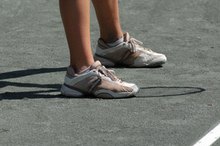Causes of Hip and Buttock Pain
Pain in the hip and buttock region affects many people. Pain experienced in this area may originate in the hip itself or be referred from conditions outside the hip.
If you are experiencing serious medical symptoms, seek emergency treatment immediately.
Most hip and buttock pain is mechanical and can be resolved through conservative treatments, but some causes can be serious. Any pain that is severe, does not resolve within a few days, or progresses requires medical evaluation.
Sciatica
Sciatica describes irritation or compression of the large sciatic nerve. It typically causes pain in the lower back, hip, buttock and the back of the leg. The condition is most commonly caused by a herniated disc in the lower spine. A herniated disc develops when the jellylike center portion of a spinal disc pushes out of its normal confines, which can put pressure on nearby nerves. Other conditions, such as age-related degeneration of the spine and bone spurs, can also irritate the sciatic nerve and cause pain.
Sciatic pain may be accompanied by muscle weakness, numbness, tingling and loss of sensation along the path of the nerve.
In most cases of sciatica, pain is limited to one side. This condition may be treated with antiinflammatory medications and exercise. Severe cases of sciatica may require surgical treatment.
- Sciatica describes irritation or compression of the large sciatic nerve.
- A herniated disc develops when the jellylike center portion of a spinal disc pushes out of its normal confines, which can put pressure on nearby nerves.
Sacroiliac Joint Pain
Causes of Nerve Pain in the Hip & Leg
Learn More
The sacroiliac joint is formed by the sacrum -- the bottom of the spinal column -- and the pelvis. **This joint is susceptible to injury.
** Pain in the buttocks and hip may originate from the sacroiliac joint.
Individuals who sit for long periods of time may have pain in these joints due to tight muscles and ligaments.
Pain may also be caused by trauma, arthritis or pregnancy. Treatment for sacroiliac joint pain includes antiinflammatory medication, cortisone injection and exercises to strengthen the muscles that support the joint 3.
- The sacroiliac joint is formed by the sacrum -- the bottom of the spinal column -- and the pelvis.
- Treatment for sacroiliac joint pain includes antiinflammatory medication, cortisone injection and exercises to strengthen the muscles that support the joint 3.
Piriformis Syndrome
The piriformis is a small muscle in the center of the buttock. This muscle is active during running and walking and is susceptible to stress.
When the piriformis is stressed, it can tighten and cause pain in the hip and buttocks. The sciatic nerve travels very close to, and in some cases, directly through the piriformis muscle.
When the muscle tightens and spasms, it can put pressure on the sciatic nerve causing many of the same symptoms that occur with herniated disc-related sciatica. Treatment includes rest from offending activities, stretching of the tight muscle and strengthening of all the muscles in the pelvic region.
- The piriformis is a small muscle in the center of the buttock.
- When the piriformis is stressed, it can tighten and cause pain in the hip and buttocks.
Ankylosing Spondylitis
Tai Chi Exercises for the Sciatica Nerve in the Back
Learn More
Ankylosing spondylitis is a chronic inflammatory condition that affects the spine and the sacroiliac joints 4.
It can progress and affect other joints throughout the body, but initial symptoms usually begin in the hips and lower spine. Hip, buttock and low back pain are common. In some cases, this condition may also affect internal organs, including the heart and lungs. Nonsurgical treatment for this condition includes physical therapy and antiinflammatory drugs or other medication for pain. Severe cases of ankylosing spondylitis can cause a permanent, stooped posture and may require surgery.
- Ankylosing spondylitis is a chronic inflammatory condition that affects the spine and the sacroiliac joints 4.
- Severe cases of ankylosing spondylitis can cause a permanent, stooped posture and may require surgery.
Other Causes
Other conditions and injuries can also cause hip and buttock pain.
For example, high hamstring muscle strains or tears can cause these symptoms, particularly among athletes. These injuries can develop suddenly or evolve gradually due to overuse. Blockage of the arteries supplying the legs -- known as aortoiliac occlusive disease -- is a less common cause of posterior hip and buttock pain. Hardening of the arteries is the usual culprit for this condition. Impingement, or compression, of muscles or tendons in the pelvis and hip region can also cause buttock and posterior hip pain.
Reviewed by: Tina M. St. John, M.D.
- Other conditions and injuries can also cause hip and buttock pain.
- Impingement, or compression, of muscles or tendons in the pelvis and hip region can also cause buttock and posterior hip pain.
Related Articles
References
- European Spine Journal: Surgery Versus Conservative Management of Sciatica Due to a Lumbar Herniated Disc -- A Systematic Review
- European Spine Journal: The Clinical Features of the Piriformis Syndrome -- A Systematic Review
- Journal of Manual and Manipulative Therapy: Evidence-Based Diagnosis and Treatment of the Painful Sacroiliac Joint
- International Journal of Inflammation: Ankylosing Spondylitis -- From Cells to Genes
- American Family Physician: Evaluation of the Patient with Hip Pain
- Journal of Family Practice: Evaluation and Management of Hip Pain: An Algorithmic Approach
- Sports Health: Posterior Hip Pain in an Athletic Population: Differential Diagnosis and Treatment Options
- Sembrano JN, Reiley MA, Polly DW, Garfin SR. Diagnosis and treatment of sacroiliac joint pain. Current Orthopaedic Practice. 2011;22(4):344-350. doi:10.1097/bco.0b013e31821f4dba.
- Arthritis Foundation. Ankylosing Spondylitis.
- Cleveland Clinic. Sacroiliitis. Updated March 13, 2018.
- Kennedy DJ, Engel A, Kreiner DS, Nampiaparampil D, Duszynski B, Macvicar J. Fluoroscopically Guided Diagnostic and Therapeutic Intra-Articular Sacroiliac Joint Injections: A Systematic Review. Pain Med. 2015;16(8):1500-18. doi:10.1111/pme.12833
- American Physical Therapy Association. Physical Therapist's Guide to Sacroiliac Joint Dysfunction. Updated October 17, 2019.
Writer Bio
Dr. Blake Biddulph received his chiropractic degree from Parker College of Chiropractic in Dallas in 2007 and has been practicing as a chiropractic physician in Provo, Utah, ever since. He has a special interest in spinal rehabilitation and treats patients with a variety of neck and back conditions. He has been writing health-related articles and newsletters for several years.








